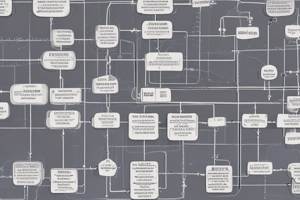Podcast
Questions and Answers
Explain the process of use case realization and its importance in software design.
Explain the process of use case realization and its importance in software design.
Use case realization is the process of elaborating the detailed design of a use case with interaction diagrams. It is important in software design as it helps in understanding the interactions between different components and layers of the system, leading to a more detailed and precise design.
What are the two types of interaction diagrams mentioned in the text, and how do they differ?
What are the two types of interaction diagrams mentioned in the text, and how do they differ?
The two types of interaction diagrams mentioned in the text are UML sequence diagram and UML communication diagram. UML sequence diagram emphasizes the sequence of messages exchanged between objects, while UML communication diagram focuses on the associations between objects.
How do sequence diagrams extend the system sequence diagram (SSD) in the context of use case realization?
How do sequence diagrams extend the system sequence diagram (SSD) in the context of use case realization?
Sequence diagrams, also known as use case realization sequence diagrams, extend the system sequence diagram (SSD) by showing the interactions and messages exchanged between different layers and components of the system, including view layer objects, domain layer objects, and data access layer objects.
What are the perfect technology, perfect memory, and perfect solution assumptions in software design, and how do they impact the initial design stages?
What are the perfect technology, perfect memory, and perfect solution assumptions in software design, and how do they impact the initial design stages?
Explain the design principle of separation of responsibilities and provide examples of how it can be implemented in software design.
Explain the design principle of separation of responsibilities and provide examples of how it can be implemented in software design.
How does the multilayer design approach address the perfect memory assumption, and why is it important in software design?
How does the multilayer design approach address the perfect memory assumption, and why is it important in software design?
Study Notes
- Use case realization is the process of designing a use case with interaction diagrams.
- Two types of interaction diagrams are used: UML sequence diagram and UML communication diagram.
- UML sequence diagram, also called use case realization sequence diagram, shows interaction between objects in a use case. It extends the system sequence diagram (SSD) to include view layer objects, domain layer objects, and data access layer objects.
- UML communication diagram shows the interaction between objects in a use case, focusing on the messaging between objects.
- Perfect technology assumption is made for use cases, meaning messages like user logging on are not included.
- Perfect memory assumption is made, assuming all necessary objects are in memory and available.
- In a multilayer design, the steps necessary to create objects in memory are included.
- Perfect solution assumption is made in the first-cut sequence diagram, assuming no exception conditions.
- Separation of responsibilities is a design principle that recommends segregating classes into separate components based on their primary focus (user interface, domain, and data access).
Studying That Suits You
Use AI to generate personalized quizzes and flashcards to suit your learning preferences.
Description
Learn about the process of elaborating detailed designs of use cases with interaction diagrams, specifically UML sequence diagram and UML communication diagram. This quiz covers the extension of system sequence diagram (SSD) to showcase view layer objects, domain layer objects, and data access layer objects.




